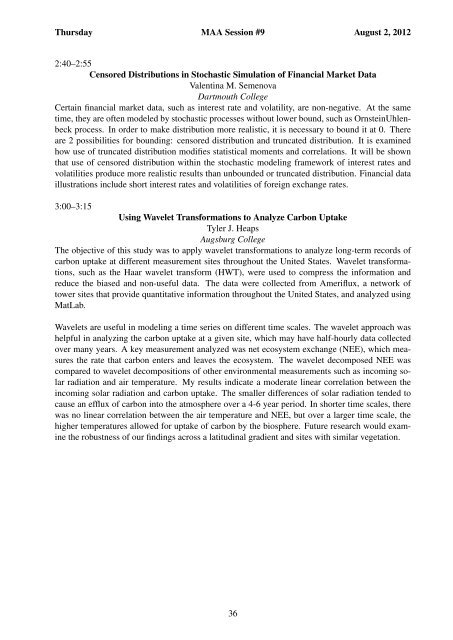Pi Mu Epsilon - Mathematical Association of America
Pi Mu Epsilon - Mathematical Association of America
Pi Mu Epsilon - Mathematical Association of America
You also want an ePaper? Increase the reach of your titles
YUMPU automatically turns print PDFs into web optimized ePapers that Google loves.
Thursday MAA Session #9 August 2, 2012<br />
2:40–2:55<br />
Censored Distributions in Stochastic Simulation <strong>of</strong> Financial Market Data<br />
Valentina M. Semenova<br />
Dartmouth College<br />
Certain financial market data, such as interest rate and volatility, are non-negative. At the same<br />
time, they are <strong>of</strong>ten modeled by stochastic processes without lower bound, such as OrnsteinUhlenbeck<br />
process. In order to make distribution more realistic, it is necessary to bound it at 0. There<br />
are 2 possibilities for bounding: censored distribution and truncated distribution. It is examined<br />
how use <strong>of</strong> truncated distribution modifies statistical moments and correlations. It will be shown<br />
that use <strong>of</strong> censored distribution within the stochastic modeling framework <strong>of</strong> interest rates and<br />
volatilities produce more realistic results than unbounded or truncated distribution. Financial data<br />
illustrations include short interest rates and volatilities <strong>of</strong> foreign exchange rates.<br />
3:00–3:15<br />
Using Wavelet Transformations to Analyze Carbon Uptake<br />
Tyler J. Heaps<br />
Augsburg College<br />
The objective <strong>of</strong> this study was to apply wavelet transformations to analyze long-term records <strong>of</strong><br />
carbon uptake at different measurement sites throughout the United States. Wavelet transformations,<br />
such as the Haar wavelet transform (HWT), were used to compress the information and<br />
reduce the biased and non-useful data. The data were collected from Ameriflux, a network <strong>of</strong><br />
tower sites that provide quantitative information throughout the United States, and analyzed using<br />
MatLab.<br />
Wavelets are useful in modeling a time series on different time scales. The wavelet approach was<br />
helpful in analyzing the carbon uptake at a given site, which may have half-hourly data collected<br />
over many years. A key measurement analyzed was net ecosystem exchange (NEE), which measures<br />
the rate that carbon enters and leaves the ecosystem. The wavelet decomposed NEE was<br />
compared to wavelet decompositions <strong>of</strong> other environmental measurements such as incoming solar<br />
radiation and air temperature. My results indicate a moderate linear correlation between the<br />
incoming solar radiation and carbon uptake. The smaller differences <strong>of</strong> solar radiation tended to<br />
cause an efflux <strong>of</strong> carbon into the atmosphere over a 4-6 year period. In shorter time scales, there<br />
was no linear correlation between the air temperature and NEE, but over a larger time scale, the<br />
higher temperatures allowed for uptake <strong>of</strong> carbon by the biosphere. Future research would examine<br />
the robustness <strong>of</strong> our findings across a latitudinal gradient and sites with similar vegetation.<br />
36
















